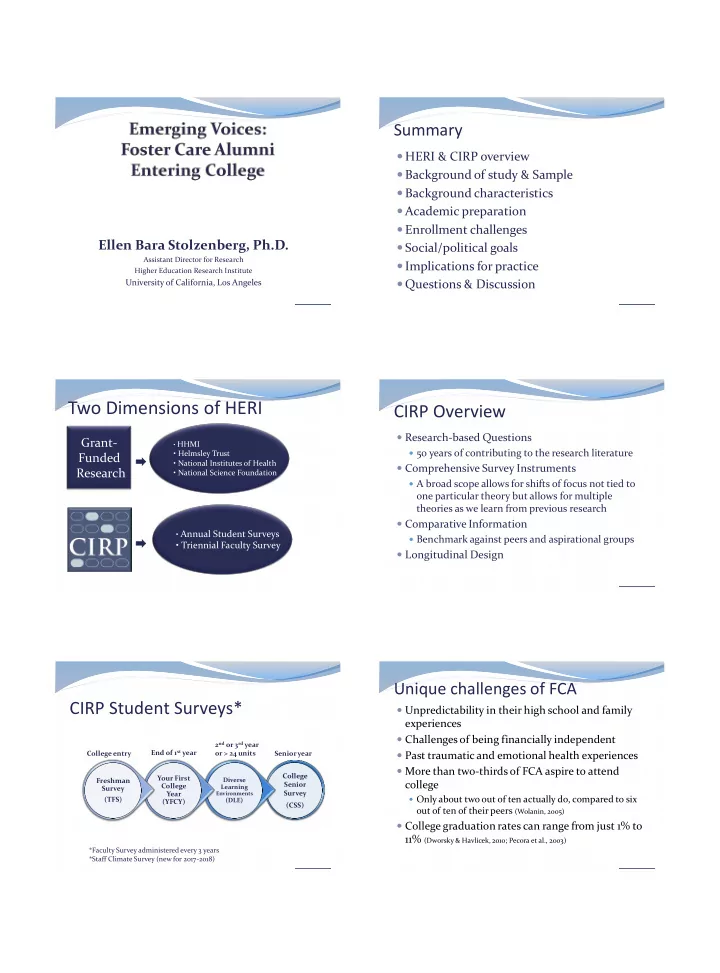

Summary HERI & CIRP overview Background of study & Sample Background characteristics Academic preparation Enrollment challenges Ellen Bara Stolzenberg, Ph.D. Social/political goals Assistant Director for Research Implications for practice Higher Education Research Institute University of California, Los Angeles Questions & Discussion Two Dimensions of HERI CIRP Overview Research-based Questions Grant- • HHMI 50 years of contributing to the research literature • Helmsley Trust Funded • National Institutes of Health Comprehensive Survey Instruments Research • National Science Foundation A broad scope allows for shifts of focus not tied to one particular theory but allows for multiple theories as we learn from previous research Comparative Information • Annual Student Surveys Benchmark against peers and aspirational groups • Triennial Faculty Survey Longitudinal Design Unique challenges of FCA CIRP Student Surveys* Unpredictability in their high school and family experiences Challenges of being financially independent 2 nd or 3 rd year End of 1 st year College entry or > 24 units Senior year Past traumatic and emotional health experiences More than two-thirds of FCA aspire to attend College Your First Diverse Freshman college Senior College Learning Survey Survey Year Environments Only about two out of ten actually do, compared to six (TFS) (DLE) (YFCY) (CSS) out of ten of their peers (Wolanin, 2005) College graduation rates can range from just 1% to 11% (Dworsky & Havlicek, 2010; Pecora et al., 2003) *Faculty Survey administered every 3 years *Staff Climate Survey (new for 2017-2018)
Sample 2016 CIRP Freshman Survey Foster care status included for the first time 1,147 students who were in foster care or a dependent Background Characteristics of the court since the age of 13 Foster Care Alumni (FCA) 213 institutions National Sample Weighted data to reflect the approximately 1.5 million first-time, full-time students who started college in Fall 2016. Featured in The American Freshman: National Norms Fall 2016 (Eagan et al, 2016). Select Background Characteristics Foster Care Status by Race/Ethnicity 100% 0.2 0.7 50.0% 8.9 American Indian 45.2% 90% 45.0% 27.1 9.7 Asian 80% 38.0% 40.0% 10.5 70% 35.0% African American/Black 30.9% 30.1% 18.1 60% 30.0% Latino/a 50% 25.0% 11.2 55.5 18.8% 20.0% 40% White 23.7 15.0% 30% Other 10.0% 20% 6.5% 2.1 1.1 5.0% Two or more 10% 17.2 13.9 race/ethnicity 0.0% 0% Non-native English First-generation Atheist, Agnostic, or FCA National Sample speaker None FCA National Sample Finances 90.0% 81.5% 80.0% HS GPA & 70.0% 56.7% 60.0% 54.2% Academic Preparation 50.0% 40.0% 29.9% 28.4% 30.0% 19.7% 20.0% 10.0% 0.0% Any funding from family Work study Pell Grant resources FCA National Sample
Academic Preparation 100.0% 89.6% 90.0% 80.0% 75.2% Enrollment Challenges 70.0% 60.0% 55.1% 50.0% 46.0% 40.0% 30.0% 20.0% 14.8% 10.0% 5.5% 0.0% Participated in Summer HS GPA (A-/A or A+) 4+ years of Math Bridge FCA National Sample Enrollment Challenges* Enrollment Challenges* 40.0% 35.0% 32.4% 34.4% 34.4% 35.0% 30.0% 30.0% 26.4% 25.0% 22.3% 25.0% 22.9% 21.2% 20.0% 20.0% 15.0% 15.0% 10.0% 9.5% 10.0% 5.0% 5.0% 0.0% Take courses from more than one Take a course exclusively online 0.0% college simultaneously Transfer to another college before Take a leave of absence from this FCA National Sample graduating college temporarily FCA National Sample *Four-year institutions only *Four-year institutions only Goals: Social Values (% Very important or essential) 70.0% 57.7% 60.0% 56.8% 54.8% 48.5% 50.0% 46.9% 46.8% Social & Political Goals 40.0% 30.0% 20.0% 10.0% 0.0% Helping to promote racial Developing a meaningful Influencing social values understanding philosophy of life FCA National Sample
Political Goals (% Very important or essential) Goals: Social Activism (% Very important or essential) 60.0% 50.0% 46.0% 45.0% 49.2% 40.7% 50.0% 45.4% 45.2% 40.0% 43.1% 33.9% 35.0% 40.0% 35.8% 30.0% 33.8% 26.9% 25.0% 30.0% 20.0% 20.0% 15.0% 10.0% 10.0% 5.0% 0.0% 0.0% Influencing the political structure Keeping up to date with political Becoming involved in Becoming a community Participating in a affairs programs to clean up the leader community action FCA National Sample environment program FCA National Sample Likelihood of Political Involvement Implications for Practice (% some chance or very good chance) 90.0% Financial aid advising 84.3% 80.0% Academic advising 70.0% 66.2% 60.0% Placement and tutoring 50.0% 42.9% 40.0% Counselors with specialized training 35.5% 30.0% Social activism 20.0% 10.0% Student organizations 0.0% Participate in student government Vote in a local, state, or national election FCA National Sample Contact Information Questions? Ellen Bara Stolzenberg, PhD Assistant Director for Research Higher Education Research Institute University of California, Los Angeles Comments? (310) 825-6991 stolzenberg@gseis.ucla.edu
Recommend
More recommend